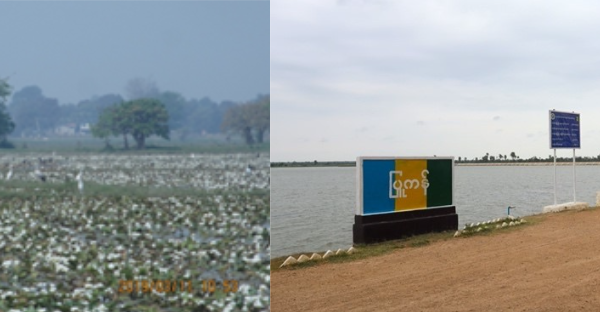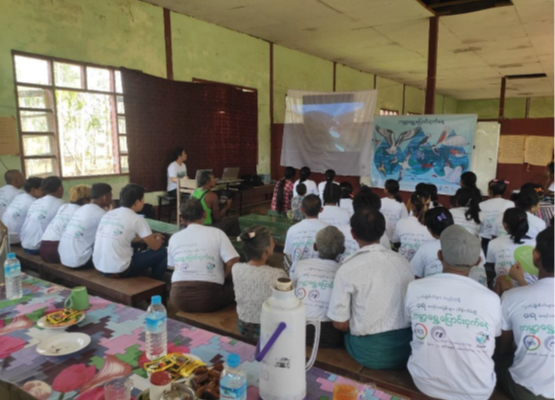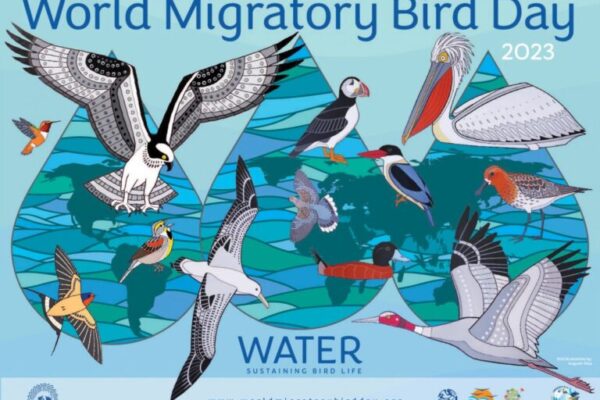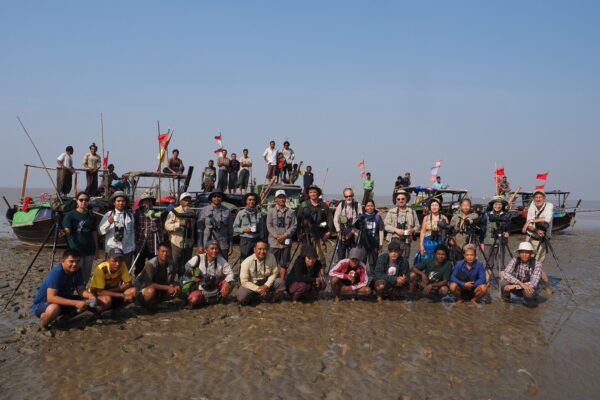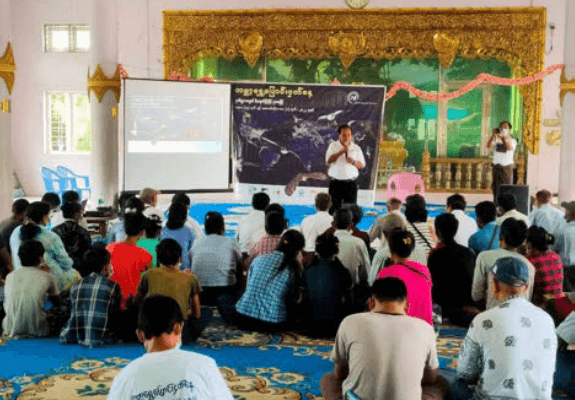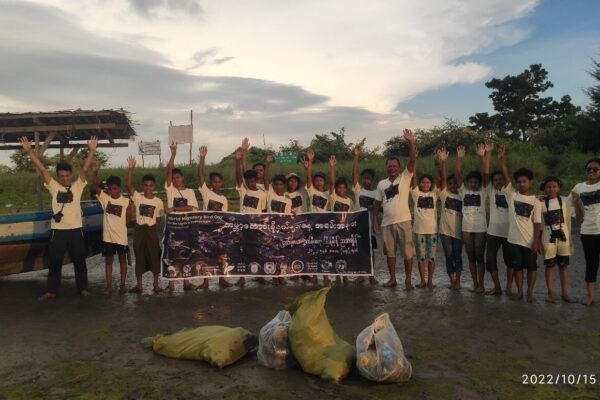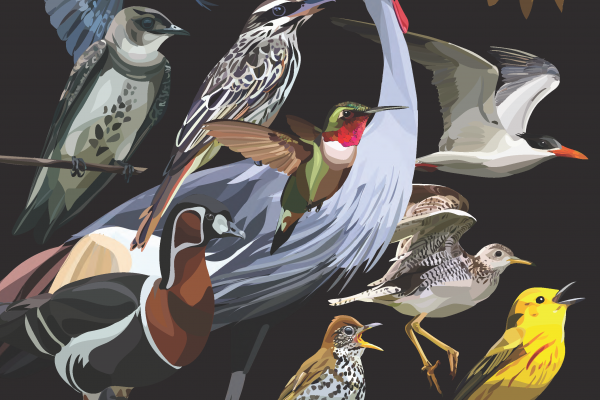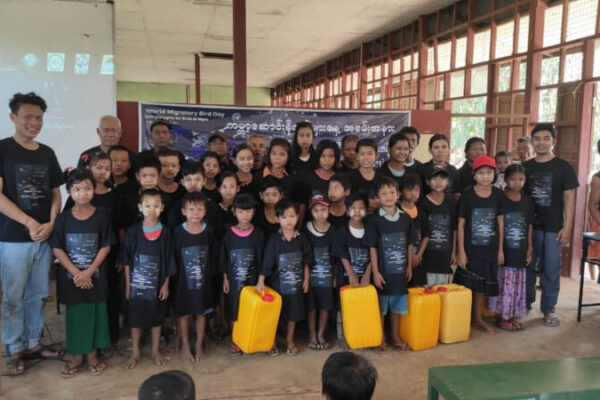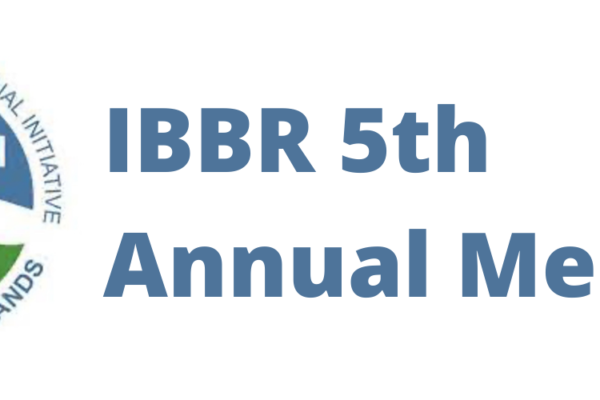-
Welcoming Paleik Lake (EAAF154) and Pyu Lake (EAAF155) as new Flyway Network Sites of Myanmar
Paleik Lake © Thiri Dae We Aung/BANCA Pyu Lake © Thiri Sandar Zaw On the 16th of November 2023, the East Asian-Australasian Partnership (EAAFP) welcomed the addition of two new Flyway Network Sites (FNS) of the Republic of the Union of Myanmar namely, Paleik Lake (EAAF154) and Pyu Lake (EAAF155), marking the seventh and eighth FNS in the country. Flock of Greylag Goose recorded in December 2016 at Paleik Lake FNS © Thiri Dae We Aung/BANCA Recognised as an Important Bird and Biodiversity Area (IBA) and a Key Biodiversity Area (KBA), Paleik Lake (EAAF154) provides food and shelter to globally threatened migratory waterbirds such as Critically Endangered Baer’s Pochard (Aythya baeri), Vulnerable Common Pochard (Aythya ferina), and other more abundant species including Greylag Goose (Anser anser), Glossy Ibis (Plegadis falcinellus), and Black-headed Ibis (Threskiornis melanocephalus), as well as a breeding ground for other waterbird species. Paleik Lake is also known to provide a variety of livelihood benefits to local communities primarily through agriculture and aquaculture by supplying water for the cultivation of rice and vegetables and as a habitat for economically important fishes and aquatic plants. Additionally, Paleik Lake plays a vital role in mitigating and adapting to climate change, specifically in preventing droughts and floods during extreme weather events. Diving duck species observed at the northeast part of Pyu Lake FNS in January 2019 © Thiri Dae We Aung Home to a diverse population of aquatic flora and fauna, Pyu Lake (EAAF155) annually supports up to 40 waterbird species including the Critically Endangered Baer’s Pochard (Aythya baeri) and the Vulnerable Common Pochard (Aythya ferina). Pyu Lake is characterised by its surrounding agricultural land with abundant crops that support the livelihoods of local communities. In addition, the presence of economically significant aquatic plants and fish in the lake greatly contributes to the preservation of traditional fishing practices among the local villagers. With no prior conservation frameworks in place or national/local legal recognition as a critical habitat for migratory waterbirds and other species, Pyu Lake’s designation as an FNS is a crucial step in ensuring that further biodiversity loss is minimised, and appropriate conservation measures are implemented. Myanmar’s Ministry of Natural Resources and Environmental Conservation established the Mandalay Region Wetlands Conservation Committee which enables the conduct of annual wintering survey and Asian Waterbird Census in both Paleik Lake and Pyu Lake, the implementation of education awareness activities focusing on migratory waterbird species, among others. Since 2016, the Biodiversity and Nature Conservation Association (BANCA) performs the annual waterbird monitoring in both sites. Moreover, the Paleik Bird Lover Association and Shwe Kan Tharyar Nature Conservation Association are local conservation groups established to conserve the biodiversity of Paleik Lake and Pyu Lake, respectively. With the valuable support of national and local conservation groups, the designation of Paleik Lake and Pyu Lake offers a ray of hope for enhanced governance and management of wetland ecosystems in Myanmar. As part of their conservation measures, management plans for Paleik Lake and Pyu Lake are intended to be developed. Both FNS are also recommended for designation as Ramsar sites by the Ramsar Administrative Authority of the Forest Department of Myanmar. The expansion of the Flyway Site Network exemplifies the unwavering commitment of the EAAFP and its Partners in conserving and restoring important habitats for migratory waterbirds both for nature and people. It is a truly remarkable partnership driven by our shared goals and appreciation to safeguard the connectivity of wetland habitats along the flyway, thereby providing safe havens for migratory waterbirds.
Continue reading -
World Migratory Bird Day 2023: Promoting Conservation Efforts and Local Engagement in Myanmar
The Nature Conservation Society-Myanmar (NCS-Myanmar) successfully organized the World Migratory Bird Day (WMBD) event for 2023 on 18th May. The event took place in Koe Tae Su Village near the Gulf of Mottama (GoM) in Myanmar, with a total of 77 participants, including school students, villagers, and local communities. Supported by the East Asian-Australasian Flyway Partnership (EAAFP), this event aimed to raise awareness about the significance of migratory birds and their habitats, while actively involving the local population in conservation efforts. © Nature Conservation Society-Myanmar The event commenced with an engaging opening ceremony, featuring a speech by the Head of the Local Community, who warmly welcomed the participants to WMBD 2023. The NCS-Myanmar team provided an insightful presentation on the formation of WMBD and its yearly themes, emphasizing the importance of water in sustaining bird life. The audience was captivated by the "Migratory Bird" song in Burmese, created specifically for WMBD 2020, along with other videos highlighting the journey and challenges faced by migratory birds. Following the opening ceremony, the workshop focused on the conservation of migratory birds in the GoM. NCS-Myanmar experts delivered presentations on various topics, including animal migration, the importance of wetlands and water for migratory birds, and the threats they face in the GoM. Participants were educated about the socio-ecological justice required for environmental conservation. They also explored the correlation between their livelihoods and migratory birds through group discussions, covering subjects such as bird hunting, attitudes towards migratory birds, traditional knowledge, local organization activities, and livelihoods and poverty reduction. © Nature Conservation Society-Myanmar One remarkable aspect of the event was the active participation of women, who contributed their valuable perspectives and visions. The attendees already had some knowledge of bird migration in their area from previous events, but this occasion provided them with a deeper understanding of the benefits of establishing conservation zones for birds. They expressed their desire for more conservation zones in the region to mitigate habitat loss and threats to migratory birds. Throughout the event, attendees enjoyed educational presentations, engaging discussions, and inspiring videos on migratory birds. The NCS-Myanmar effectively fostered an atmosphere of learning and enjoyment, ensuring that participants gained a comprehensive understanding of the importance of environmental conservation and habitat preservation for migratory birds. © Nature Conservation Society-Myanmar The World Migratory Bird Day 2023 event in Myanmar, organized by NCS-Myanmar, proved to be a resounding success, as it helped to raise awareness about migratory birds and their habitats among local communities, students, and villagers. By actively involving participants in workshops and discussions, NCS-Myanmar empowered the local population to contribute to the conservation of migratory birds in the GoM. The event highlighted the need for socio-ecological justice and emphasized the crucial role of water in sustaining bird life. It is hoped that such initiatives will continue to be organized, promoting environmental conservation and habitat preservation for migratory birds in their flyways. The project was funded through the 2023 EAAFP WMBD Small Grant Fund. View the report, Click here. Article prepared by Nature Conservation Society-Myanmar
Continue reading -
World Migratory Bird Day 2023 highlights impact of the growing water crisis on migratory birds
BOULDER/BONN/INCHEON, 13 May 2023 – Water and its importance to migratory birds – and the increasing threats to both water quality and quantity - is the focus of this year’s World Migratory Bird Day, a global campaign that aims to raise awareness of migratory birds and the need for international cooperation to conserve them. Activities to mark the campaign will be held globally on two peak days in May and October under the theme “Water: Sustaining Bird Life” Water is fundamental to sustaining life on our planet. Migratory birds rely on water and its associated habitats—lakes, rivers, streams, ponds, swamps, marshes, and coastal wetlands—for breeding, resting, refueling during migration, and wintering. Yet increasing human demand for water, along with climate change, pollution, and other factors, are threatening these precious aquatic ecosystems. Headlines around the world are sounding alarm: 35 percent of the world’s wetlands, critical to migratory birds, have been lost in the last 50 years. Utah’s Great Salt Lake, the largest saltwater lake in the Western Hemisphere and used by more than a million shorebirds, is in danger of disappearing within five years. Across the Amur-Heilong Basin in Asia, climate change is amplifying the impact of habitat destruction by depleting natural water systems and depriving migratory birds of vital breeding and stopover site. These sobering examples go hand-in-hand with recent reports that reveal that 48 percent of bird species worldwide are undergoing population declines. Another poignant example is that of the Aral Sea shared by Kazakhstan and Uzbekistan. Once the fourth-largest lake in the world, it is widely regarded as one of the planet’s worst water-related environmental disasters. Soviet-era irrigation projects almost completely dried up the lake, which led to the loss of livelihoods for fishermen and farmers and the deterioration of public health due to toxic dust and reduced access to clean water. The impact has been severe for the communities around the lake, but also for migratory birds, which lost important food sources and a critically important stopover point on their journey. Another example is the Sahel, a vast semi-arid region in Africa: Prolonged periods of drought, deforestation, and overgrazing in the Sahel have led to the degradation of the soil and loss of vegetation, threatening the survival of both the local human population and wildlife, including migratory birds. Lake Chad, one of the largest water bodies in Africa in 1960, lost 90 % of its area, depleting water resources for local communities and also for many migratory birds. World Migratory Bird Day serves as an international call to action for the protection of migratory birds, whose ranges often span multiple countries, and are facing many different threats worldwide. The annual campaign is organized by the Convention on the Conservation of Migratory Species of Wild Animals (CMS), the African-Eurasian Migratory Waterbird Agreement (AEWA), Environment for the Americas (EFTA), and the East Asian-Australasian Flyway Partnership (EAAFP). World Migratory Bird Day 2023 will be officially held on 13 May and 14 October. The two days of World Migratory Bird Day reflect the cyclical nature of bird migration as well as the fact that there are varying peak migration periods in the northern and southern hemispheres. Events to raise awareness of migratory birds and the importance of water will take place all over the world including in local parks, nature centers, museums, libraries, schools, and other locations on these peak days and throughout the year. To learn more about this year’s World Migratory Bird Day campaign and actions to take, visit www.worldmigratorybirdday.org and EAAFP WMBD 2023 webpage: https://www.eaaflyway.net/world-migratory-bird-day-2023/ Also, please have a look of the Campaign Strategy for promoting World Migratory Bird Day, click [here]. For more resources, visit the Trello Board [here]. Message from the Partners of World Migratory Bird Day Convention on Migratory Species (CMS) “Water is essential for people as well as for migratory birds and other wild species of animals. Yet around the world, the availability and quality of water is under enormous pressure, with deeply concerning implications. The looming global water crisis requires urgent action by governments, businesses, local communities as well as individuals. Because migratory birds cross national borders and even continents, international cooperation is essential to ensure that actions are taken to conserve and restore important habitat for migratory birds, and to address the drivers of water loss, pollution, and climate change,” said Amy Fraenkel, Executive Secretary of the Convention on the Conservation of Migratory Species of Wild Animals (CMS). African-Eurasian Migratory Waterbird Agreement (AEWA) “The water crisis recently highlighted by the UN 2023 Water Conference also has a tremendous impact on migratory birds. In the Sahel in particular, many wetlands on which migratory waterbirds rely during the non-breeding period are shrinking. Water is a vital resource for all, local communities as well as birds. By reducing our consumption, combatting climate change, and managing wetlands wiser, we can improve the situation,” said Dr. Jacques Trouvilliez, Executive Secretary of the Agreement on the Conservation of African-Eurasian Migratory Waterbirds (AEWA). Environment for the Americas (EFTA) “World Migratory Bird Day 2023 spotlights the vital role that water plays in the survival of our shared birds. The focal species illustrated on the campaign poster depict the intricate bond each bird shares with water. The diminutive Rufous Hummingbird thrives on nectar-producing flowers that rely on water for their blooms, and the Dickcissel scours the grasslands for seeds that hold the moisture they need. White Pelicans and Ospreys seek their prey in freshwater lakes, while the magnificent Wandering Albatross and Atlantic Puffin remain at sea. WMBD is an opportunity to unify our voices for the conservation of migratory birds and to celebrate their spectacular journeys,” said Dr. Susan Bonfield, Executive Director at Environment for the Americas (EFTA). East Asian-Australasian Flyway Partnership (EAAFP) “This year's WMBD theme serves as a vital reminder of the linkage of migratory birds to the importance of protecting aquatic ecosystems and conserving wetlands. As birds such as threatened Spoon-billed Sandpiper, Dalmatian Pelican, and Sarus Crane migrate, they rely heavily on wetlands for survival. We must take urgent actions and collaborate at all levels, from citizens to among governments, to tackle the problems of saving water and aquatic ecosystem, and ensure that migratory birds continue to thrive.” Ms. Yeounhee Ahn, Deputy Executive of East Asian-Australasian Flyway Partnership (EAAFP).
Continue reading -
Conservation of Spoon-billed Sandpiper in the Gulf of Mottama and Tanintharyi Coastal of Myanmar
EAAFP Small Grant Fund Project by Pyae Phyo Aung, Shane Thu Lwin and Thura Soe Min Htike Nature Conservation Society – Myanmar (NCS) LCG members are looking the spotting the scope and binocular during the bird watching training © Nature Conservation Society – Myanmar Participation of local communities in conservation is crucial for long-term conservation management. Two local Conservation Groups(LCGs) newly established in The Tanintharyi region are improved their conservation skills through five consecutive bird-watching training sessions. Two LCGs from the area of the Gulf of Mottama are also trained to elaborate their bird-watching, patrolling and conservation skills. Vinyl billboards were installed in the public areas of Myeik and Boke Pyin to raise the awareness of the conservation of migratory shorebirds during their wintering season. This year, 2021-2022 a total of nine national surveyors conducted an annual wintering census survey of Spoon-billed Sandpiper and migratory shorebirds at the Gulf of Mottama and Tanintharyi coastal accompanied by the LCGs members. For the Gulf of Mottama Ramsar site, the survey team covered upper Gulf located in east coastal where recorded 17 and estimated 80 critically endangered Spoon-billed Sandpiper (SBS), based on the SBS proportion in 173 flock counts of over 34,914 birds extrapolated to an estimated 160,000 birds of small waders in the area. These birds were encountered by the team at low tide feeding and widespread across the vast mudflat habitats. Former hunters of the Local Conservation Groups (LCGs) joined the survey and guided the survey team onto the small wader flocks. They were trained and informed about the survey techniques, biology and significance of the species in a regional, national and global context. Providing binoculars to LCG team © Nature Conservation Society – Myanmar Survey team members with LCG at the Gulf of Mottama © Nature Conservation Society – Myanmar Three sites located at the North of Myeik mudflat, recorded ten globally threatened species such as Nordmann’s Green Shank, Great Knot, Chinese Egret, Black-headed Ibis, Bar-tailed Godwit, Black-tailed Godwit, Eurasian Curlew, Curlew Sandpiper, Red-necked/Little Stint and Red-breasted Parakeet. Three sites located at the Bokepyin mudflat, recorded twelve globally threatened species such as single Spoon-billed Sandpiper, Black-tailed Godwit, Bar-tailed Godwit, Eurasian Curlew, Nordmann’s Greenshank. During the project implementation period, NCS keep communicating with the existing LCG members in the Gulf of Mottama for the conservation actions and formation the new LCG team at Tanintharyi coastal region. Tanintharyi costal region is also important for migratory water birds and needs to be conserved as a legal flyway network site or Ramsar Site. Moreover, the NCS team is coordinating with Tanintharyi region Forest Department for the Spoon-billed Sandpiper conservation activities and introducing Tanintharyi coastal as a new flyway network site. Discussion between NCS and Officers from Forest Department for shorebird conservation, Tanintharyi Region via Zoom on 30 November 2021© Nature Conservation Society – Myanmar The project was funded through the 2021 EAAFP WG/TF Small Grant Fund. View the report, Click here.
Continue reading -
2023 Spoon-billed Sandpiper Census in the Gulf of Mottama, Myanmar
Survey team of 2023 Spoon-billed Sandpiper Census in Myanmar in January 2023 © Spoon-billed Sandpiper Task Force For the twelfth consecutive year the Nature Conservation Society- Myanmar (NCS) in close collaboration with the Spoon-billed Sandpiper Task Force (SBS TF) organised the Spoon-billed Sandpiper winter survey and waterbird monitoring expedition. The Gulf of Mottama Ramsar Site is a hugely important intertidal mudflat in Myanmar hosting thousand of migratory waterbirds including the critically endangered Spoon-billed Sandpiper and supporting local people’s livelihoods such as fishery. The Spoon-billed Sandpiper Task Force and its local partner have carried out annual shorebird monitoring surveys at the Gulf of Mottama over the last 15 years. However, due to the Covid-19 pandemic impact the 2020-2022 surveys were carried out without any international participation. In 2023 (NCS) organised a total of 20 surveyors from China, Russia, Thailand Germany, US and Myanmar, who were accompanied by 40 local boat crew who have been surveyed the East (Mon State) and West (Bago Region) of the Gulf of Mottama for 5 days between 20-25 January 2023. Local experts were trained to the Local Conservation Group members during the survey period for basic birdwatching, and flock scanning that will help for future citizen science surveys. Overall preliminary results of the total small wader population in significantly decreased to approximatelyonly 60000 which is one-third less than in previous years. Further analysis is still ongoing, but sadly, the Spoon-billed Sandpiper has also declined and is estimated based on flock count to less than 20 individuals. According to the local fishermen information hunting is now resuming in some places in the Gulf of Mottama area and stronger law enforcement is needed. The survey was generously supported by the Mangrove Conservation Fund Shenzhen (MCF), the International Union for Conservation of Nature (IUCN) through the Gulf of Mottama Project and the Manfred-Hermsen Foundation, Germany.
Continue reading -
Welcoming the migratory bird for the first time at Paleik Lake in Mandalay region, central Myanmar
On 1 October 2022, Biodiversity And Nature Conservation Association collaborated with the Shwe Kantharyar Nature Conservation Association, a community- based organization in Pyu Lake, and celebrated the first time…
Continue reading -
World Migratory Bird Day in Nanthar Island Marine National Park, Rakhine State
Nature Conservation Society-Myanmar (NCS) in cooperation with Rakhine Biodiversity and Nature Conservation Association(RBANCA) and the Forest Department organized the second World Migratory Bird Day(WMBD) event for 2022 at the…
Continue reading -
-
Celebrating 2022 World Migratory Bird Day in Villages near the Gulf of Mottama, Myanmar
Group photo of the participants to the WMBD 2022 at GoM ©️ NCS On 10 May 2022, Nature Conservation Society-Myanmar (NCS) organized the World Migratory Bird Day(WMBD) event for 2022 in Basic Education Primary School, Koe Tae Su Village, Belin Township near Gulf of Mottama(GoM) in Myanmar with financial support from EAAFP WMBD Small Grant Fund. The purpose of organizing this event was to raise awareness in local communities on how WMBD was formed and held annually all around the world, and to educate the local communities about the importance of the conservation of migratory birds and wetland ecosystems. A total of 104 participants joined the event and most of participants were school students and local communities from villages around GoM. Members of Local Conservation Groups (LCG) from Koe Te Su village have also joined the event. Presentation on WMBD and the theme, Light Pollution©️ NCS The event started with visual presentations about the history of WMBD, annual celebrations, the theme of this year - light pollution, and migratory shorebirds, wetland conservation and Ramsar sites were presented. The “Migratory Bird” song and video clips of the six EAAFP Flyway Network Sites in Myanmar and light pollution were shown. The team presented the mangrove forest status and its conservation in Myanmar. Quiz and games were included in the event with an online platform, covering the critically endangered Spoon-billed Sandpiper (SBS), light pollution and migratory birds. the. Questions were shown on the screen and participants were encouraged to the answer quickly. The participants whowere the first to answer correctly won prizes. School students aged between 5 and 10 played the Spoon-billed Sandpiper (SBS) finding game and kids who could find the greatest number of SBS were awarded. Kids playing the Spoon-billed Sandpiper finding game ©️ NCS Awarding participants who could answer the quiz ©️ NCS Local communities and students were more aware of the theme of WMBD for this year especially the value of the natural dark, increasing light pollution, the impacts of the light pollution on migratory birds and nocturnal animals. They also learned about the six Ramsar sites in Myanmar and their importance in their livelihoods. Participants have also observed the conservation status of the threatened species including the Critically Endangered Spoon-billed Sandpiper that migrate to the Gulf of Mottama and the efforts of local and international organizations working for the conservation. The audience were fascinated by such a little bird to migrate over thousands of kilometres. They were aware that the migratory birds are fully protected under Myanmar Conservation of Biodiversity and Protected areas Law. Participants enjoyed the songs, presentations and videos, had fun during the quiz and game session. T-shirts with the 2022 WMBD global poster printed on the front were distributed to the participants as souvenirs. Participants during the Presentation on the Conservation of Migratory Birds and Wetlands ©️ Nature Conservation Society-Myanmar Article prepared by Nature Conservation Society-Myanmar (NCS).
Continue reading

